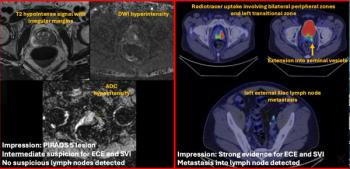
Simple schema aids arthritis diagnosis
Differential diagnosis of arthritic joint conditions and degenerative spinal disorders can be far from straightforward. Leading musculoskeletal radiologists at the European Congress of Radiology in Vienna showed how careful evaluation of imaging data can improve diagnostic accuracy.
Differential diagnosis of arthritic joint conditions and degenerative spinal disorders can be far from straightforward. Leading musculoskeletal radiologists at the European Congress of Radiology in Vienna showed how careful evaluation of imaging data can improve diagnostic accuracy.
Joint pathology can occur in three key areas: the synovium, hyaline cartilage and subchrondral bone, and entheseal insertions. Radiologists seeking to diagnose basic peripheral arthritis should first assess which of these three areas is most affected, said Dr. Iain Watt, a radiologist at the Leiden University Medical Center in the Netherlands. A checklist of possible pathological features within each group should then lead to the most likely diagnosis.
One of the first things to look for in the synovium is x-ray opacity. This may indicate iron deposition from hemophilia or calcium deposits, for instance. Swelling is another important marker and a possible indication of synovitis.
"The more inflamed the joint is and the bigger the swelling, the more ill defined it becomes and the more you should think of infection," he said.
Classification of synovial erosions as either active or inactive and evaluation of new bone formation can further help narrow down the diagnostic options. Ill-defined erosions are suggestive of active disease and most likely to be rheumatoid arthritis. Inert erosions with no soft-tissue swelling are more likely indicative of gout. Observation of new bone formation adjacent to the erosion should trigger suspicion of psoriasis or reactive arthritis.
Hyaline cartilage is attracting considerable attention in the radiological literature at present because of its excellent visualization on MRI, he said. Basic diagnostic signs can also be seen on plain film, however. Thick cartilage is a classic hallmark of acromegaly. Thin cartilage is associated with a variety of pathological conditions, but it is also a normal sign of aging. Care must be taken not to confuse thinning cartilage in elderly patients with pathological cartilage destruction.
The most significant question concerning enthesis disease is whether it is erosive or nonerosive, according to Watt. Forestier's disease is the most common nonerosive endotheseal disorder. Erosive conditions include ankylosing spondylitis, psoriasis, and Reiter's syndrome.
Another major task for musculoskeletal radiologists is distinguishing the 5% of back pain patients with infection, inflammation, or neoplasm from the 95% of individuals whose discomfort is due to a mechanical cause. While plain-film radiography is of limited value, x-rays can indicate certain signs of disc degeneration: disc space narrowing, sclerosis, and osteocyte formation. But diagnosis of degeneration is best made on MRI, said Prof. Iain McCall, a professor of radiology at the Robert Jones and Agnes Hunt Hospital in Oswestry, U.K.
Other common sign of spinal degeneration is annular bulging, or a circumferential extension of the disc beyond the endplate. Herniation of nuclear material can also occur. The herniations can be graded according to the severity of symptoms, McCall said. The posterior annulus remains intact in protrusions, whereas it is disrupted in extrusions. Sequestration involves migration of material away from the disc.
"If the patient can stand the pain, there is a high probability that sequestrations will resolve spontaneously. Similarly for extrusions," he said. "For the protrusions, it is much more difficult."
Notice should also be taken of the nerve root, which if compressed, can cause sciatica. So-called high-intensity zones on T2-weighted MRI are less significant, contrary to previously held beliefs, he said.
"High-intensity zones do represent posterior annular tears, and they certainly may be symptomatic and produce quite intense back pain," he said. "But studies have shown that there is a relatively poor positive predictive value of symptoms from high-intensity zones."
Both CT and MRI can be used to examine facet osteoarthritis and produce a grading of 0 to III according to severity. Intraobserver variation appears to be better with CT, though the relevance of a grading scheme is itself questionable.
"A grading system for osteoarthritis may be of value. However, I have to say that no relationship has been shown between facet osteoarthritis and low back pain," McCall said.
Identification of cysts on facet joints, while rare, is an important finding, he said. Sciatica may be due to a facet cyst and not disc herniation. This distinction should be made before the patient reaches the operating table.
Newsletter
Stay at the forefront of radiology with the Diagnostic Imaging newsletter, delivering the latest news, clinical insights, and imaging advancements for today’s radiologists.




























